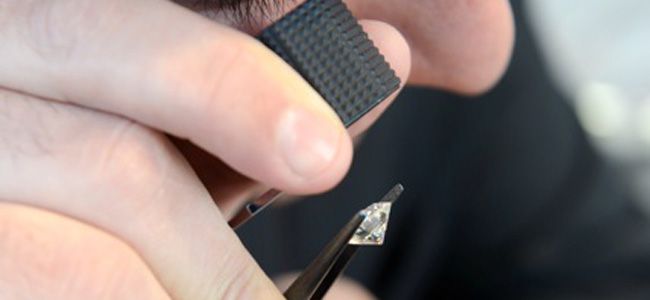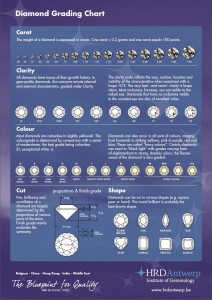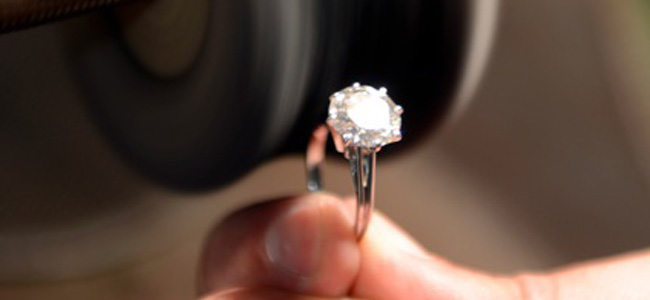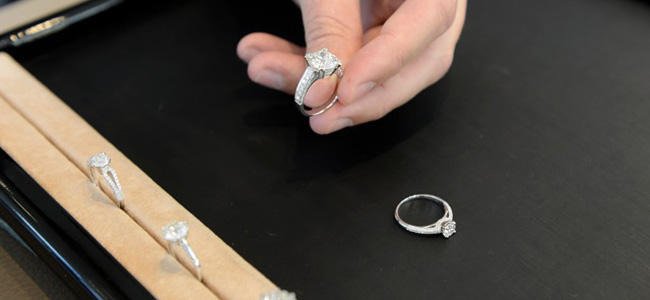
Qualities (purity, large size and color) of some diamonds are the most popular gemstones in jewelry.
The beauty of his shine is because it has a high refractive index of light and a large dispersive power: penetrating, light rays are reflected inside the stone infinity and light white disperses back inside transformed into a range of colors. Diamonds (like water drops) function as prisms braking, more or less depending on the wavelength (violet maximum, minimum red), so that the colors are spread in the form of a rainbow.
All diamonds are not used in jewelery.
The slightest defect can remove them value and they are then used for industrial applications. These internal bubbles or foreign particles, poor color or when they have an irregular shape.
Diamond cutting is done primarily in Antwerp (Belgium), Tel Aviv (Israel) and Gujarat (India) by the Jain community. In Thailand, it is the precious stones like rubies and sapphires are cut.
The degree of the beauty of the dispersion (rainbow effect rainbow) diamond depends largely on the size and polish the stone. Although naturally the diamond chips have their own, they can be improved and the size multiplied by an expert diamond.
Because of its extreme hardness, diamonds can not be machined by another diamond, so the size and polish of the stone are the most important elements.
Before cutting examines the gem to determine its cleavage planes. Then trace on it a line that marks the perimeter of these plans. Thereon, a small groove is made with a kind of wood in its end which carries a diamond. Through this opening, a thin steel blade is introduced, we give a rap stone is divided into two.
There are many ways to cut the diamond.
The fifteenth to the seventeenth century, the practice size tip (polishing the tip of the octahedron) and the table in (polishing the faces of the crystal diamond powder). Paints portraits of the period show a black diamond because these techniques are very effective. In the seventeenth century appears the “brilliant” cut, size best known, one that puts the best in the beauty of the diamond and is therefore the most used. This advanced technique can transform raw gems in light stone, showing 58 facets (57 if we do not take into account the culet): 33 on the crown and 24 on the yoke, regular and defined size specifically, the surface of the diamond.
Indeed, if the notions of purity and color seem familiar, the proportions of size are more rarely. However, they are an essential factor of quality. They directly affect the rendering of brilliance and “fire” of the diamond. At the same color, a diamond with good proportions will be much brighter than pure diamond cut incorrectly.
Since the onset of Tolkovsky size in 1919, the diamond have consistently sought to optimize the rendering of diamond’s brilliance. All sizes of diamond is definitely the round brilliant was the most studied and is the most successful; Today, the proportions applied to this size direct result of understanding the optical laws of the material and technical mastery of cutting and polishing.
In Japan, the size arrow and hearts is very popular and so named because the shapes of the play of light products. The apprentice tailors are very rare twenty-first century, the size being increasingly performed by lasers using computer systems.
Diamonds are also color coded.
The most common color is “white” (absence of color: that is to say that the diamond is transparent and colorless). These colors are rated from D (the purest white) to Z (the darkest shade):
Color code
Exceptional White + D
E Exceptional White
F White + extra
G White extra
H White
I and J White nuanced
K and L Slightly tinted
M to Z Color marked
In Japan, the size arrow and hearts is very popular and so named because the shapes of the play of light products. The apprentice tailors are very rare twenty-first century, the size being increasingly performed by lasers using computer systems.



